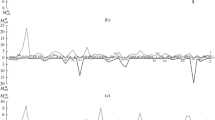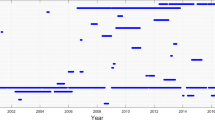Abstract
During the ACE-Asia field campaign, 41 aerosol filter samples were obtained by airborne sampling over the ocean to the north, south and west of Japan, generally under conditions of outflow from the Asian continent. These samples were analyzed for their water-soluble chemical components, particularly organic species. Suites of inorganic anions, carbohydrates, organic acids and metallic elements were identified and quantified (21 distinct species). Simultaneously, measurements were made of the aerosol hygroscopicity and light scattering. A factor analysis performed on the compositional data identified several sources for the aerosols sampled during the field campaign. Regression of the light-scattering data onto tracers for each of these factors suggests that the aerosol light scattering could be largely attributed to three of these factors: anthropogenic emissions, biomass burning, and soil dust. Similarly, the aerosol hygroscopicity was largely consistent with an empirical mixing model based on past measurements of the hygroscopicity of these individual aerosol types. Limited size-resolved , aerosol composition measurements were also obtained and suggested different sources for various chemical species.
Similar content being viewed by others
References
Anderson, T. A. and J. A. Ogren, 1998: Determining aerosol radiative properties using the TSI 3563 integrating nephelometer, Aerosol Sci. Technol. 29, 57-69.
Bond, T. C., Anderson, T. A., and Campbell, C., 1999: Calibration and intercomparison of filter-based measurements of visible light absorption by aerosols, Aerosol Sci. Technol. 30, 582-600.
Chameides, W. L., Yu, H., Liu, S. C., Bergin, M., Zhou, X., Mearns, L., Wang, G., Kiang, C. S., Saylor, R. D., Luo, C., Huang, Y., Steiner, A., and Giorgi, F., 1999: Case study of the effects of atmospheric aerosols and regional haze on agriculture: An opportunity to enhance crop yields in China through emissions controls, PNAS 96, 13626-13633.
Charlson, R. J., Schwartz, S. E., Hales, J. M., Cess, R. D., Coakley Jr., J. A., Hansen, J. E., and Hoffmann, D. J., 1992: Climate forcing by anthropogenic aerosols, Science 255, 423-430.
Clegg, S. L., Seinfeld, J. H., and Brimblecombe, P., 2001: Thermodynamic modeling of aqueous aerosols containing electrolytes and dissolved organic compounds, J. Aerosol Sci. 32, 713-738.
Covert, D. S., Charlson, R. J., and Ahlquist, N. C., 1972: A study of the relationship of chemical composition and humidity to light scattering by aerosols, J. Appl. Meteorol. 11, 968-976.
Fredenslund, A., Gmehling, J., and Rasmussen, P., 1977: Vapor-Liquid Equilibrium Using UNIFAC, Elsevier, Amsterdam.
Fraser, M. P. and Lakshmanan, K., 2000: Using levoglucosan as a molecular marker for the longrange transport of biomass combustion aerosols, Environ. Sci. Technol. 34, 4560-4564.
Gao, S., Hegg, D. A., Frick, G., Caffrey, P., Pasternack, L., Cantrell, C., Sullivan, W., Ambrusko, J., Albrechinski, T., and Kirchstetter, T. W., 2001: Experimental and modeling studies of secondary organic aerosol formation and some applications to the marine boundary layer, J. Geophys. Res. 106, 27619-27634.
Gao, S., Hegg, D. A., Hobbs, P. V., Kirchstetter, T. W., Magi, B. J., and Sadilek, M., 2002: Water-soluble organic components in aerosols associated with savanna fires in southern Africa: Identification, evolution, and distribution, J. Geophys. Res., in press.
Gasso, S., Hegg, D. A., Covert, D. S., Collins, D., Noone, K. J., Ostrom, E., Schmid, B., Russell, P. B., Livingston, J. M., Durkee, P. A., and Jonsson, H., 2000: Influence of humidity on the aerosol scattering coefficient and its effect on the upwelling radiance during ACE-2, Tellus 52B, 546-567.
Hatakeyama, S., Tanonaka, T., Weng, J., Bandow, H., Takagi, H., and Akimoto, H., 1985: Ozonecyclohexene reaction in air: Quantitative analysis of particulate products and the reaction mechanism, Environ. Sci. Technol. 19, 935-942.
Hatakeyama, S., Ohno, M., Weng, J., Takagi, H., and Akimoto, H., 1987: Mechanism for the formation of gaseous and particulate products from ozone-cycloalkene reactions in air, Environ. Sci. Technol. 21, 52-57.
Hegg, D. A., Covert, D. S., Crahan, K., and Jonsson, H., 2002: The dependence of aerosol light scattering on RH over the Pacific Ocean, Geophys. Res. Lett. 29, 60-1-60-4.
Hegg, D. A., Livingston, J., Hobbs, P. V., Novakov, T., and Russell, P., 1997: Chemical apportionment of column optical depth off the mid-Atlantic coast of the United States, J. Geophys. Res. 102, 25293-25303.
IPCC, 2001: Climate Change 2001, The Scientific Basis, Cambridge University Press, Cambridge, U.K., p. 881.
Jaffe, D., Anderson, T., Covert, D., Kotchenruther, R., Trost, B., Danielson, J., Simpson, W., Berntsen, T., Karlsdottir, S., Blake, D., Harris, J., Carmichael, G., and Uno, I., 1999: Transport of Asia air anthropogenic emissions to North America, Geophys. Res. Lett. 26, 711-714.
Juntto, S. and Paatero, P., 1994: Analysis of daily precipitation data by positive matrix factorization, Environmetrics 5, 127-144.
Kasten, F., 1969: Visibility forecast in the phase of pre-condensation, Tellus 21, 631-635.
Kato, N. and Akimoto, H., 1992: Anthropogenic emissions of SO2 and NOxin Asia: Emission inventories, Atmos. Environ. 26, 2992-3017.
Kawamura, K. and Ikushima, K., 1993: Seasonal changes in the distribution of dicarboxylic acids in the urban atmosphere, Environ. Sci. Technol. 27, 2227-2235.
Kawamura, K., Sempéré, R., Imai, Y., Fujii, Y., and Hayashi, M., 1996: Water soluble dicarboxylic acids and related compounds in Antarctic aerosols, J. Geophys. Res. 101,18,721-18,728.
Kawamura, K. and Sakaguchi, F., 1999: Molecular distributions of water soluble dicarboxylic acids in marine aerosols over the Pacific Ocean including tropics, J. Geophys. Res. 104, 3501-3509.
Kotchenruther, R. A. and Hobbs, P. V., 1998: Humidification factors of aerosol from biomass burning in Brazil, J. Geophys. Res. 103, 32081-32089.
Kotchenruther, R. A., Hobbs, P. V., and Hegg, D. A., 1999: Humidification factors for atmospheric aerosol off the mid-Atlantic coast of the United States, J. Geophys. Res. 104, 2239-2251.
Marple, V. A., Rubow, K. L., and Behm, S. M., 1991: A Micro-Orifice Uniform Deposit Impactor (MOUDI): Description, calibration, and use, Aerosol Sci. Technol. 14, 434-446.
McMurry, P. H. and Wilson, J. C., 1982: Growth laws for the formation of secondary ambient aerosols: Implications for chemical conversion mechanisms, Atmos. Environ. 16, 121-134.
Ming, Y. and Russell, L. M., 2001: Predicted hygroscopic growth of sea salt aerosol, J. Geophys. Res. 106, 28259-28274.
Oppo, C., Bellandi, S., Degli Innocenti, N., Stortini, A. M., Loglio, G., Schiavata, E., and Cini, R., 1999: Surfactant components ofmarine organic matter as agents for biogeochemical fractionation and pollutant transport via marine aerosols, Marine Chem. 63, 235-253.
Paatero, P. and Tapper, U., 1994: Positive matrix factorization: A non-negative factor model with optimal utilization of error estimates of data values, Environmetrics 5, 111-126.
Peng, C. and Chan, C. K., 2001: The water cycles of water-soluble organic salts of atmospheric importance, Atmos. Environ. 35, 1183-1192.
Penner, J. E., Charlson, R. J., Hales, J. M., Laulainen, N., Leifer, R., Novakov, T., Ogren, J., Radke, L. F., Schwartz, S. E., and Travis, L., 1994: Quantifying and minimizing uncertainty of climate forcing by anthropogenic aerosols, Bull. Amer. Meteorol. Soc. 75, 375-400.
Pilinis, C., Pandis, S. N., and Seinfeld, J. H., 1995: Sensitivity of direct climate forcing by atmospheric aerosols to aerosol size and composition, J. Geophys. Res. 100, 18739-18754.
Quinn, P. K., Coffman, D. J., Kapustin, V. N., Bates, T. S., and Covert, D. S., 1998: Aerosol optical properties in the marine boundary layer during the First Aerosol Characterization Experiment (ACE-1) and the underlying chemical and physical aerosol properties, J. Geophys. Res. 103, 16,547-16,563.
Röhrl, A. and Lammel, G., 2001: Low-molecular weight dicarboxylic acids and glyoxylic acid: Seasonal and air mass characteristics, Environ. Sci. Technol. 35, 95-101, 2001.
Shen, Z. L., Wu, Y. X., Xiao, H., Bai, C. H., and Huang, M. Y., 1993: Some basic features of cloudwater chemistry in Southwest China, Cin. J. Atmos. Sci. 17, 195-205.
Simoneit, B. R. T., Schauer, J. J., Nolte, C. G., Oros, D. R., Elias, V. O., Naser, M. P., Rogge, W. J., and Cass, G. R., 1999: Levoglucosan: A tracer for cellulose in biomass burning and atmospheric particles, Atmos. Environ. 33, 173-182.
Tang, I. N., 1996: Chemical and size effects of hygroscopic aerosols on light scattering coefficients, J. Geophys. Res. 101, 19,245-19,250.
Uematsu, M., Yoshikawa, A., Muraki, H., Arao, K., and Uno, I., 2002: Transport of mineral and anthropogenic aerosols during a Kosa event over East Asia, J. Geophys. Res. 107, AAC3-1-7.
Wang, J., Flagan, R. C., Seinfeld, J. H., Jonsson, H. H., Collins, D. R., Russell, P. B., Schmid, B., Redemann, J., Livingston, J. M., Gao, S., Hegg, D. A., Welton, E. J., and Bates, D., 2002: Clearcolumn radiative closure during ACE-Asia: Comparison of multiwavelength extinction derived from particle size and composition with results from sunphotometry, J. Geophys. Res., accepted.
Xie, Y.-L., Hopke, P. K., Paatero, P., Barrie, L. A., and Li, S.-M., 1999: Identification of source nature and seasonal variations of arctic aerosol by positive matrix factorization, J. Atmos. Sci. 56, 249-260.
Zhang, X. Y., Arimoto, R., Zhu, G. H., Chen, T., and Zhang, G. Y., 1998: Concentration, size-distribution and deposition of mineral aerosol over Chinese desert regions, Tellus 50B, 317-330.
Author information
Authors and Affiliations
Rights and permissions
About this article
Cite this article
Gao, S., Hegg, D.A. & Jonsson, H. Aerosol Chemistry, and Light-Scattering and Hygroscopicity Budgets during Outflow from East Asia. Journal of Atmospheric Chemistry 46, 55–88 (2003). https://doi.org/10.1023/A:1024821409130
Issue Date:
DOI: https://doi.org/10.1023/A:1024821409130




